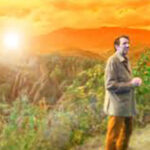by Paramahansa Yogananda: “Return to india. I have waited for you patiently for fifteen years. Soon I shall swim out of the body and on to the Shining Abode. Yogananda, come!”
Sri Yukteswar’s voice sounded startlingly in my inner ear as I sat in meditation at my Mt. Washington headquarters. Traversing ten thousand miles in the twinkling of an eye, his message penetrated my being like a flash of lightning.
Fifteen years! Yes, I realized, now it is 1935; I have spent fifteen years in spreading my guru’s teachings in America. Now he recalls me.
That afternoon I recounted my experience to a visiting disciple. His spiritual development under Kriya Yoga was so remarkable that I often called him “saint,” remembering Babaji’s prophecy that America too would produce men and women of divine realization through the ancient yogic path.
This disciple and a number of others generously insisted on making a donation for my travels. The financial problem thus solved, I made arrangements to sail, via Europe, for India. Busy weeks of preparations at Mount Washington! In March, 1935 I had the Self-Realization Fellowship chartered under the laws of the State of California as a non-profit corporation. To this educational institution go all public donations as well as the revenue from the sale of my books, magazine, written courses, class tuition, and every other source of income.
“I shall be back,” I told my students. “Never shall I forget America.”
At a farewell banquet given to me in Los Angeles by loving friends, I looked long at their faces and thought gratefully, “Lord, he who remembers Thee as the Sole Giver will never lack the sweetness of friendship among mortals.”
I sailed from New York on June 9, 19351 in the Europa. Two students accompanied me: my secretary, Mr. C. Richard Wright, and an elderly lady from Cincinnati, Miss Ettie Bletch. We enjoyed the days of ocean peace, a welcome contrast to the past hurried weeks. Our period of leisure was short-lived; the speed of modern boats has some regrettable features!
Like any other group of inquisitive tourists, we walked around the huge and ancient city of London. The following day I was invited to address a large meeting in Caxton Hall, at which I was introduced to the London audience by Sir Francis Younghusband. Our party spent a pleasant day as guests of Sir Harry Lauder at his estate in Scotland. We soon crossed the English Channel to the continent, for I wanted to make a special pilgrimage to Bavaria. This would be my only chance, I felt, to visit the great Catholic mystic, Therese Neumann of Konnersreuth.
Years earlier I had read an amazing account of Therese. Information given in the article was as follows:
(1) Therese, born in 1898, had been injured in an accident at the age of twenty; she became blind and paralyzed.
(2) She miraculously regained her sight in 1923 through prayers to St. Teresa, “The Little Flower.” Later Therese Neumann’s limbs were instantaneously healed.
(3) From 1923 onward, Therese has abstained completely from food and drink, except for the daily swallowing of one small consecrated wafer.
(4) The stigmata, or sacred wounds of Christ, appeared in 1926 on Therese’s head, breast, hands, and feet. On Friday of every week thereafter, she has passed through the Passion of Christ, suffering in her own body all his historic agonies.
(5) Knowing ordinarily only the simple German of her village, during her Friday trances Therese utters phrases which scholars have identified as ancient Aramaic. At appropriate times in her vision, she speaks Hebrew or Greek.
(6) By ecclesiastical permission, Therese has several times been under close scientific observation. Dr. Fritz Gerlick, editor of a Protestant German newspaper, went to Konnersreuth to “expose the Catholic fraud,” but ended up by reverently writing her biography.2
As always, whether in East or West, I was eager to meet a saint. I rejoiced as our little party entered, on July 16th, the quaint village of Konnersreuth. The Bavarian peasants exhibited lively interest in our Ford automobile (brought with us from America) and its assorted groupan American young man, an elderly lady, and an olive-hued Oriental with long hair tucked under his coat collar.
Therese’s little cottage, clean and neat, with geraniums blooming by a primitive well, was alas! silently closed. The neighbors, and even the village postman who passed by, could give us no information. Rain began to fall; my companions suggested that we leave.
“No,” I said stubbornly, “I will stay here until I find some clue leading to Therese.”
Two hours later we were still sitting in our car amidst the dismal rain. “Lord,” I sighed complainingly, “why didst Thou lead me here if she has disappeared?”
An English-speaking man halted beside us, politely offering his aid.
“I don’t know for certain where Therese is,” he said, “but she often visits at the home of Professor Wurz, a seminary master of Eichstatt, eighty miles from here.”
The following morning our party motored to the quiet village of Eichstatt, narrowly lined with cobblestoned streets. Dr. Wurz greeted us cordially at his home; “Yes, Therese is here.” He sent her word of the visitors. A messenger soon appeared with her reply.
“Though the bishop has asked me to see no one without his permission, I will receive the man of God from India.”
Deeply touched at these words, I followed Dr. Wurz upstairs to the sitting room. Therese entered immediately, radiating an aura of peace and joy. She wore a black gown and spotless white head dress. Although her age was thirty-seven at this time, she seemed much younger, possessing indeed a childlike freshness and charm. Healthy, well-formed, rosy-cheeked, and cheerful, this is the saint that does not eat!
Therese greeted me with a very gentle handshaking. We both beamed in silent communion, each knowing the other to be a lover of God.
Dr. Wurz kindly offered to serve as interpreter. As we seated ourselves, I noticed that Therese was glancing at me with naive curiosity; evidently Hindus had been rare in Bavaria.
“Don’t you eat anything?” I wanted to hear the answer from her own lips.
“No, except a consecrated rice-flour wafer, once every morning at six o’clock.”
“How large is the wafer?”
“It is paper-thin, the size of a small coin.” She added, “I take it for sacramental reasons; if it is unconsecrated, I am unable to swallow it.”
“Certainly you could not have lived on that, for twelve whole years?”
“I live by God’s light.” How simple her reply, how Einsteinian!
“I see you realize that energy flows to your body from the ether, sun, and air.”
A swift smile broke over her face. “I am so happy to know you understand how I live.”
“Your sacred life is a daily demonstration of the truth uttered by Christ: ‘Man shall not live by bread alone, but by every word that proceedeth out of the mouth of God.’”3
Again she showed joy at my explanation. “It is indeed so. One of the reasons I am here on earth today is to prove that man can live by God’s invisible light, and not by food only.”
“Can you teach others how to live without food?”
She appeared a trifle shocked. “I cannot do that; God does not wish it.”
As my gaze fell on her strong, graceful hands, Therese showed me a little, square, freshly healed wound on each of her palms. On the back of each hand, she pointed out a smaller, crescent-shaped wound, freshly healed. Each wound went straight through the hand. The sight brought to my mind distinct recollection of the large square iron nails with crescent-tipped ends, still used in the Orient, but which I do not recall having seen in the West.
The saint told me something of her weekly trances. “As a helpless onlooker, I observe the whole Passion of Christ.” Each week, from Thursday midnight until Friday afternoon at one o’clock, her wounds open and bleed; she loses ten pounds of her ordinary 121-pound weight. Suffering intensely in her sympathetic love, Therese yet looks forward joyously to these weekly visions of her Lord.
I realized at once that her strange life is intended by God to reassure all Christians of the historical authenticity of Jesus’ life and crucifixion as recorded in the New Testament, and to dramatically display the ever-living bond between the Galilean Master and his devotees.
Professor Wurz related some of his experiences with the saint.
“Several of us, including Therese, often travel for days on sight-seeing trips throughout Germany,” he told me. “It is a striking contrastwhile we have three meals a day, Therese eats nothing. She remains as fresh as a rose, untouched by the fatigue which the trips cause us. As we grow hungry and hunt for wayside inns, she laughs merrily.”
The professor added some interesting physiological details: “Because Therese takes no food, her stomach has shrunk. She has no excretions, but her perspiration glands function; her skin is always soft and firm.”
At the time of parting, I expressed to Therese my desire to be present at her trance.
“Yes, please come to Konnersreuth next Friday,” she said graciously. “The bishop will give you a permit. I am very happy you sought me out in Eichstatt.”
Therese shook hands gently, many times, and walked with our party to the gate. Mr. Wright turned on the automobile radio; the saint examined it with little enthusiastic chuckles. Such a large crowd of youngsters gathered that Therese retreated into the house. We saw her at a window, where she peered at us, childlike, waving her hand.
From a conversation the next day with two of Therese’s brothers, very kind and amiable, we learned that the saint sleeps only one or two hours at night. In spite of the many wounds in her body, she is active and full of energy. She loves birds, looks after an aquarium of fish, and works often in her garden. Her correspondence is large; Catholic devotees write her for prayers and healing blessings. Many seekers have been cured through her of serious diseases.
Her brother Ferdinand, about twenty-three, explained that Therese has the power, through prayer, of working out on her own body the ailments of others. The saint’s abstinence from food dates from a time when she prayed that the throat disease of a young man of her parish, then preparing to enter holy orders, be transferred to her own throat.
On Thursday afternoon our party drove to the home of the bishop, who looked at my flowing locks with some surprise. He readily wrote out the necessary permit. There was no fee; the rule made by the Church is simply to protect Therese from the onrush of casual tourists, who in previous years had flocked on Fridays by the thousands.
We arrived Friday morning about nine-thirty in Konnersreuth. I noticed that Therese’s little cottage possesses a special glass-roofed section to afford her plenty of light. We were glad to see the doors no longer closed, but wide-open in hospitable cheer. There was a line of about twenty visitors, armed with their permits. Many had come from great distances to view the mystic trance.
Therese had passed my first test at the professor’s house by her intuitive knowledge that I wanted to see her for spiritual reasons, and not just to satisfy a passing curiosity.
My second test was connected with the fact that, just before I went upstairs to her room, I put myself into a yogic trance state in order to be one with her in telepathic and televisic rapport. I entered her chamber, filled with visitors; she was lying in a white robe on the bed. With Mr. Wright following closely behind me, I halted just inside the threshold, awestruck at a strange and most frightful spectacle.
Blood flowed thinly and continuously in an inch-wide stream from Therese’s lower eyelids. Her gaze was focused upward on the spiritual eye within the central forehead. The cloth wrapped around her head was drenched in blood from the stigmata wounds of the crown of thorns. The white garment was redly splotched over her heart from the wound in her side at the spot where Christ’s body, long ages ago, had suffered the final indignity of the soldier’s spear-thrust.
Therese’s hands were extended in a gesture maternal, pleading; her face wore an expression both tortured and divine. She appeared thinner, changed in many subtle as well as outward ways. Murmuring words in a foreign tongue, she spoke with slightly quivering lips to persons visible before her inner sight.
As I was in attunement with her, I began to see the scenes of her vision. She was watching Jesus as he carried the cross amidst the jeering multitude. 4 Suddenly she lifted her head in consternation: the Lord had fallen under the cruel weight. The vision disappeared. In the exhaustion of fervid pity, Therese sank heavily against her pillow.
At this moment I heard a loud thud behind me. Turning my head for a second, I saw two men carrying out a prostrate body. But because I was coming out of the deep superconscious state, I did not immediately recognize the fallen person. Again I fixed my eyes on Therese’s face, deathly pale under the rivulets of blood, but now calm, radiating purity and holiness. I glanced behind me later and saw Mr. Wright standing with his hand against his cheek, from which blood was trickling.
“Dick,” I inquired anxiously, “were you the one who fell?”
“Yes, I fainted at the terrifying spectacle.”
“Well,” I said consolingly, “you are brave to return and look upon the sight again.”
Remembering the patiently waiting line of pilgrims, Mr. Wright and I silently bade farewell to Therese and left her sacred presence.5
The following day our little group motored south, thankful that we were not dependent on trains, but could stop the Ford wherever we chose throughout the countryside. We enjoyed every minute of a tour through Germany, Holland, France, and the Swiss Alps. In Italy we made a special trip to Assisi to honor the apostle of humility, St. Francis. The European tour ended in Greece, where we viewed the Athenian temples, and saw the prison in which the gentle Socrates6 had drunk his death potion. One is filled with admiration for the artistry with which the Greeks have everywhere wrought their very fancies in alabaster.
We took ship over the sunny Mediterranean, disembarking at Palestine. Wandering day after day over the Holy Land, I was more than ever convinced of the value of pilgrimage. The spirit of Christ is all-pervasive in Palestine; I walked reverently by his side at Bethlehem, Gethsemane, Calvary, the holy Mount of Olives, and by the River Jordan and the Sea of Galilee.
Our little party visited the Birth Manger, Joseph’s carpenter shop, the tomb of Lazarus, the house of Martha and Mary, the hall of the Last Supper. Antiquity unfolded; scene by scene, I saw the divine drama that Christ once played for the ages.
On to Egypt, with its modern Cairo and ancient pyramids. Then a boat down the narrow Red Sea, over the vasty Arabian Sea; lo, India!
1 The remarkable inclusion here of a complete date is due to the fact that my secretary, Mr. Wright, kept a travel diary.
2 Other books on her life are Therese Neumann: A Stigmatist of Our Day, and Further Chronicles of Therese Neumann, both by Friedrich Ritter von Lama (Milwaukee: Bruce Pub. Co.).
3 Matthew 4:4. Man’s body battery is not sustained by gross food (bread) alone, but by the vibratory cosmic energy (word, or AUM). The invisible power flows into the human body through the gate of the medulla oblongata. This sixth bodily center is located at the back of the neck at the top of the five spinal chakras (Sanskrit for “wheels” or centers of radiating force). The medulla is the principal entrance for the body’s supply of universal life force (AUM), and is directly connected with man’s power of will, concentrated in the seventh or Christ Consciousness center (Kutastha) in the third eye between the eyebrows. Cosmic energy is then stored up in the brain as a reservoir of infinite potentialities, poetically mentioned in the Vedas as the “thousand-petaled lotus of light.” The Bible invariably refers to AUM as the “Holy Ghost” or invisible life force which divinely upholds all creation. “What? know ye not that your body is the temple of the Holy Ghost which is in you, which ye have of God, and ye are not your own?”-I Corinthians 6:19.
4 During the hours preceding my arrival, Therese had already passed through many visions of the closing days in Christ’s life. Her entrancement usually starts with scenes of the events which followed the Last Supper. Her visions end with Jesus’ death on the cross or, occasionally, with his entombment.
5 Therese has survived the Nazi persecution, and is still present in Konnersreuth, according to 1945 American news dispatches from Germany.
6 A passage in Eusebius relates an interesting encounter between Socrates and a Hindu sage. The passage runs: “Aristoxenus, the musician, tells the following story about the Indians. One of these men met Socrates at Athens, and asked him what was the scope of his philosophy. ‘An inquiry into human phenomena,’ replied Socrates. At this the Indian burst out laughing. ‘How can a man inquire into human phenomena,’ he said, ‘when he is ignorant of divine ones?’” The Aristoxenus mentioned was a pupil of Aristotle, and a noted writer on harmonics. His date is 330 B.C.










































